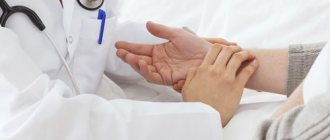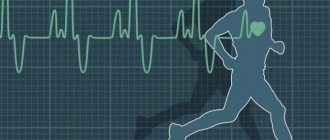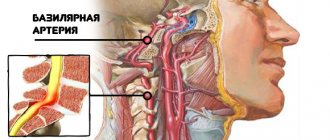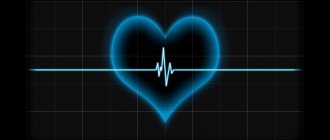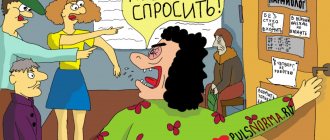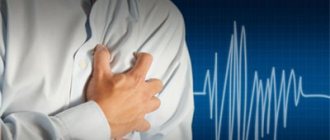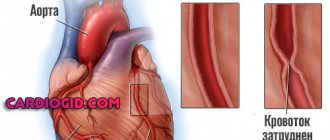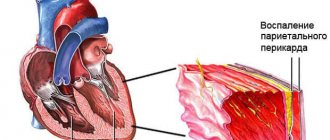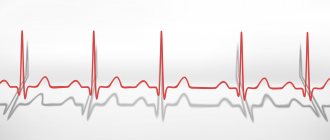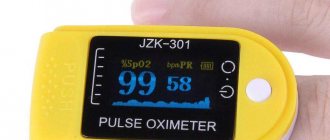Functions in the body
The pulse refers to the oscillation of the arteries, which is caused by the flow of blood into them. A push or beat indicates a contraction of the heart. As a result, the blood vessels are compressed due to the movement of blood through them. The indicator is measured in beats per minute.
The pulse can be used to determine a person's health status. First of all, the indicator speaks about the functionality of the cardiovascular system. Additionally, it is possible to identify the child’s physical fitness.
The pulse has a classification. The varieties are listed in the table.
| Pulse name | Description |
| Arterial | The walls of the blood vessels contract as blood leaves the heart. The pulse is determined by touching the arteries - in the arm (radial) or neck (carotid). |
| Capillary | The pulse is also called Quincke's pulse. Capillary index means a change in nail color synchronous with arterial waves. The pulse is determined on the nail. If a person is healthy, when the upper part of the plate is pressed, its half turns pale. And there is redness at the bottom of the nail. There should be a clear boundary between these colors until the pressure on the plate stops. This is called a negative Quincke reaction. If the aortic valve is damaged, during systole (contraction of the ventricles and blood flow) the nail turns red. And during diastole (relaxation of the organ), the plate turns white. This is a positive Quincke reaction. |
| Venous | Involves the presence of a pulse in the jugular (neck) or other veins that are close to the heart. If a person is healthy, waves are detected only visually. And during palpation, the pulse is difficult to determine due to low pressure in the veins and weak tension in the walls of blood vessels. The volume of the vein changes due to the pressure difference in the vessel. If the flow of venous blood to the right atrium is normal, the jugular veins in a healthy person are not noticeable in an upright position. Their filling occurs when intrathoracic pressure increases. For example, during straining, coughing, singing. In a horizontal position, the vein should be filled to 1/3 of its length above the collarbone. When a person stands up, the overflow disappears. |
In addition to the variety, the pulse has characteristics. Detailed information is shown in the table.
| Name | Description |
| Frequency | Another name is heart rate (HR). The value reflects the contraction of the artery walls. The following types of heart rate are distinguished:
Rare heartbeats are called bradycardia. And tachycardia is frequent vibrations of the artery walls. Sometimes the pulse becomes less than the heart rate. This is due to the fact that with weak contractions, an insufficient amount of blood enters the aorta, and the wave does not reach the arteries. |
| Rhythm | These are the intervals that appear between pulse waves. Normally, PS should be rhythmic. That is, the waves follow each other at the same time. In case of rhythm disturbance, the pulse becomes arrhythmic. That is, the waves follow each other at irregular intervals. |
| Filling | A value that means the amount of blood leaving the artery at the height of the pulse. The indicator can be moderate, full (exceeds the norm), empty (palpation of waves is impossible). Additionally, there is thread-like filling (barely noticeable). |
| Voltage | Understands the force required to completely stop blood flow. There is moderate, hard and soft tension. The value is related to blood pressure (BP). The higher the blood pressure, the more intense the pulse. For example, with hypertension, force is required to compress the artery and stop pulsation (hard). And with low blood pressure, everything is done easily, the pulse disappears even with little effort (soft). |
| Height | This is a displacement of the vibrations of the walls of the arteries. To determine the indicator, the sum of the tension and fullness of the pulse is determined. There is a large, small and moderate wave. |
| Speed or form |
|
conclusions
From the above, the following conclusions can be drawn:
- The heart rate can increase during physical labor, sports, or when emotional situations arise (after some time, tachycardia caused for these reasons goes away on its own).
- If the pulse rises even in a calm state (and this persists for a long time), then such a malaise indicates that the person has some kind of health problem. It is especially necessary to consult a specialist if you have a rapid heartbeat with normal blood pressure.
- It is not tachycardia that needs to be treated, but the disease that caused it. Finding out the reason why your heart rate increases should be the main task to get rid of this unpleasant condition. The success of recovery depends precisely on the correctness of the diagnosis and timely consultation with a doctor.
In no case should you expect that causeless constant tachycardia will go away on its own over time. Moreover, you cannot self-medicate. Diseases can be dangerous. It’s better not to waste time and entrust your health to professionals.
How and under what conditions does it appear?
A normal heart rate for a 15-year-old teenager can range from 61 to 81 beats/min. The indicator appears in the body due to the work of the heart. Its life activity is similar to a pump. That is, the heart pumps blood into the arteries.
Pulse waves are formed at the mouth of the aortic valve when fluid exits the left ventricle into the aorta and then spreads through the vessels at high speed. Stroke volume of blood occurs when systolic pressure increases, that is, the diameter of the arteries expands. And during diastole, the walls are restored to their original size.
The further the vessels are from the heart, the lower the pulse. For example, in capillaries it is impossible to feel the wave at the level of arterioles (small arteries).
Indicator table is normal
Compared to adults, teenagers have a faster heart rate. This is explained by intense metabolic processes and rapid contraction of the heart. The most frequent pulse is observed in newborns. As you get older, the rate gradually decreases.
The normal heart rate in children is shown in the table.
| Age category of the child | Normal heart rate (in beats/min.) | Average value (in beats/min.) |
| Up to 1 month | 71 – 171 | 141 |
| 1 – 12 months | 81 – 163 | 131 |
| 1 – 2 years | 95 – 155 | 125 |
| 24 years | 91 – 141 | 116 |
| 4 – 6 years | 87 – 127 | 105 |
| 6 – 8 years | 79 – 127 | 99 |
| 8 – 10 years | 69 – 109 | 89 |
| 10 – 12 years | 61 – 100 | 81 |
| 12 – 15 years | 56 – 96 | 76 |
| 15 years and above | 61 – 81 | 71 |
When exposed to physical activity, the indicator changes. In teenagers it can be 120 – 150 beats/min. The pulse should be measured not only after sports, but also after 5 – 15 minutes. from the end of classes. Normally, the blows should not become more frequent.
If a child is involved in professional sports, after training the heart rate may increase to 100 - 120 beats/min. That is, there is a general decrease in the indicator, the heart works less to obtain nutrients. During competition, your heart rate may increase. This is due to the combination of physical activity and emotional experiences.
You can roughly calculate the value beyond which your heart rate should not go beyond during sports. To do this, subtract the child’s age from 220. For example, a 12-year-old teenager’s heart rate during physical activity should not exceed 208.
The minimum value of the indicator is calculated according to a different scheme - from 220 it is necessary to subtract the child’s age and the number of heartbeats before performing physical activity, then multiply by 0.5 and add the heart rate before sports.
Using these formulas, it is possible to adjust the activity of athletes and children with excessive mobility. If after sports the child’s pulse is not higher than the upper limit and does not go beyond the lower limit, everything is normal, the load is not maximum.
Running at a heart rate of 120-130: is it safe?
Running at a heart rate of 120-130 beats per minute is safe for the heart in the absence of diseases and for people under 55 years of age. This load belongs to the recovery mode and helps:
- adapt the heart to the increased need for oxygen;
- improve overall endurance;
- reduce the amount of fat in the body;
- open reserve capillaries;
- strengthen muscles.
For training, trained athletes use a pulse of up to 150-160 beats. This rhythm leads to a gradual slowdown in resting heart rate if the training plan is correctly constructed. If you are sick, you cannot rely on such numbers. It is necessary to choose a load that does not cause a deterioration in the nutrition of the heart; most often, a heart rate of 115-120 beats per minute is considered the limit.
A pulse of 130 occurs with heart disease, non-cardiac diseases, as well as the external influence of stress and physical activity. An ECG and blood tests are used to make a diagnosis. Treatment can be carried out with medications, folk remedies and non-drug methods; sometimes surgery is needed to restore the rhythm.
Symptoms of increase and decrease
The normal heart rate of a 12-year-old teenager is between 55 and 100 beats/min. PS can deviate more or less. A decrease or increase is characterized by certain symptoms.
In the first case, the following symptoms may appear:
- coldness and paleness of the skin;
- increased irritability;
- worsening sleep;
- lethargic state;
- labored breathing;
- changes in blood pressure;
- dizziness;
- cold sweat;
- lack of coordination;
- nausea and vomiting;
- lack of air;
- chest pain;
- darkening of the eyes;
- mood changes;
- loss of consciousness;
- constant fainting;
- cardiac arrest (in critical cases).
When your heart rate is high, the following symptoms may occur:
- discomfort;
- rapid heartbeat - the process may be accompanied by jerking movements in the chest area;
- pain in the chest (symptom may be absent);
- anxiety, especially at night;
- headache;
- dizziness;
- sleep disturbance;
- difficulties with performing the usual load;
- changes in blood pressure;
- increased sweating;
- loss of consciousness.
Reasons for promotion and demotion
The normal heart rate of a 13-year-old teenager is between 56 and 96 beats/min. But there is a deviation of the indicator up or down. An increase or decrease in heart rate is associated with a disease or physiological cause. Detailed information is shown in the table.
| Change in heart rate | Physiological reasons | Possible pathologies |
| Promotion | Exceeding the indicator may indicate the following reasons:
| An elevated rate may indicate the following disorders:
|
| Demotion | Low heart rate may be due to the following reasons:
| A low rate may be associated with the following disorders:
|
First aid
First aid for tachycardia consists of the following:
- Don’t panic, but quickly, if possible, call someone for help;
- Unfasten the collar, ensure sufficient flow of fresh air;
- You can drink Corvalol, Valocordin, motherwort tincture, valerian;
- Wash with ice water, put a cold compress on your forehead;
- Close your eyes, press firmly on your eyeballs for 10 seconds, repeat several times;
- You can take a deep breath, hold your breath and push as if on the toilet. Do all this for 3-5 minutes;
- Try to cough hard.
How to determine
The pulse of a teenager (12 - 18 years old) must be monitored to compare it with the norm.
Measurements can be taken at the following locations:
- wrist;
- ulnar artery (slightly below the elbow);
- elbow bend;
- armpit;
- temple area;
- neck (carotid artery);
- lower jaw and corner of the mouth;
- inner thigh;
- bend of the leg (below the knee);
- foot.
The most common places where the pulse is measured are the extremities (wrist) and neck.
To monitor the indicator at home, the following methods can be used:
- Palpation. You should choose the hand on which the pulsation is better. If everything is the same, then you need a limb close to the heart. You need to find a point that has a pronounced pulsation and press it with your ring finger. Next, count the number of blows in 1 minute, compare the result with the norm. You can use another method - count the number of beats for 6 seconds, then multiply the number by 10. If it is impossible to hear the pulse on the wrist, measurement on the carotid artery is allowed. To do this, you need to sit or lay the person down and press on the artery with your index finger. Next, count the number of beats in 6 or 60 seconds. In the first case, multiply the indicator by 10.
- Using an electronic tonometer . Modern devices can count pulse together with measuring blood pressure. The result is displayed on the tonometer screen.
- Heart rate monitor. The device is designed to analyze heart rate, monitor the load and functionality of the heart. There are different types of heart rate monitors - on the chest, on the finger, on the arm.
Before measuring, you must adhere to the following rules:
- exclude physical activity;
- rest before measurement for 5 – 10 minutes;
- eliminate stress 1 – 2 hours before measurement;
- stop smoking 2 - 3 hours before measuring your pulse;
- do not drink strong coffee or alcohol;
- do not measure your pulse after a hot bath or swimming;
- Do not eat heavily or fast before taking measurements;
- you need to take measurements 1 – 2 hours after waking up;
- remove tight clothing, as it can compress the artery.
Getting rid of bad habits
Patients who constantly have a resting pulse of 125 are advised to completely eliminate smoking, drinking alcohol and drinking strong coffee. It is very important to avoid stressful situations, replace heavy loads with lighter ones, take vitamins, and also start your day with a contrast shower and morning exercises.
Decoding the results
The normal pulse of a 17-year-old teenager can be found in the table. After the measurement, the value should be compared. If the indicator deviates slightly from the norm, it is impossible to say with a 100% guarantee that the child has some kind of disease.
Normal heart rate in teenagers, children and adults
This may be due to physiological reasons or incorrect measurement.
When to see a doctor
If the pulse constantly deviates from the optimal value or various symptoms appear (chest pain, dizziness), it is recommended to visit a specialist for diagnosis. First you should contact a therapist - this is a general practitioner.
The specialist will conduct a survey, during which it is necessary to talk about the symptoms, if any. Next, important indicators are measured (pulse, blood pressure, temperature). Then the teenager's body is examined.
Next, the therapist can write a referral to another specialist, depending on the cause of the change in pulse. For example, if you suspect endocrine diseases, you should visit an endocrinologist.
After passing through all the specialists, a diagnosis is prescribed. For example, if a heart disease is suspected, a teenager may be referred for an electrocardiogram (ECG), 24-hour monitoring (Holter) and other procedures.
If a person’s well-being rapidly deteriorates or there are serious symptoms (fainting, severe heart pain), an ambulance should be called.
Green tea with milk
Green tea, mixed with warm milk, is good for reducing high heart rate. This remedy quickly normalizes blood pressure and heartbeat, and also restores rhythm. Tachycardia, which is caused by temporary causes, does not require treatment.
As soon as a person returns to a normal state (rests after a run, calms down after a conflict), the pulse returns to normal. In all other cases, specialist advice is required. For example, if tachycardia is provoked by medications, the doctor will prescribe an analogue without such side effects.
How to get it back to normal
Therapy is prescribed when the pulse deviates from the optimal value.
Treatment includes the following methods:
- medications;
- folk remedies;
- proper nutrition;
- physical activity.
In some cases, surgery is recommended. This happens if a change in pulse indicates a disease. For example, in the case of oncology, surgery may be performed. The need and type of intervention is determined by a specialist depending on the cause of the pulse deviation and the individual characteristics of the body.
If PS was slightly above or below the optimal value and returned to normal on its own, no therapy is required.
Medications
Medicines are not always used to treat abnormal pulses. For example, medications are not used if the situation has normalized with the help of folk remedies, proper nutrition, and sports. When a violation of the indicator indicates a disease, medications are often prescribed.
Specific medications depend on the degree and cause of the pulse deviation from normal. Additionally, the individual characteristics of the body are taken into account. If the pulse is high or low, the medications listed in the table may be prescribed.
| Group name | Action | List of funds |
| Sedatives | The drugs normalize a person’s emotional state and eliminate excessive nervousness. | Afobazol, Tenoten, Novo-Passit |
| Antihypertensive | Medicines lower high blood pressure. | Enap, Amlodipine, Bisoprolol |
| Cardiac glycosides | The drugs normalize the contractile and pumping function of the heart. Additionally, the products in this group restore metabolism, nutrition and cellular respiration. | Digoxin, Korglykon, Strophanthin |
| Antiarrhythmic | The drugs are used for heart rhythm disorders. | Cordarone, Sotahexal, Amiodarone |
| Tranquilizers | Products that have a calming effect. After taking it, anxiety, fear and any emotional stress disappear. This group of drugs is stronger than sedatives. Tranquilizers are sold from pharmacies strictly according to a doctor's prescription. | Phenazepam, Dormicum, Elenium |
| Diuretics | The drugs remove excess fluid from the body and are prescribed for high blood pressure. | Veroshpiron, Hydrochlorothiazide, Diuver |
| Thyroid hormones | Medicines are prescribed for hypothyroidism. | L-thyroxine, Euthyrox |
| Caffeinated | The drugs tone blood vessels, raise blood pressure and pulse. | Caffeine-sodium benzoate, Citramon, Coficil-plus |
| Vitamin complexes | The products restore the lack of vitamins and microelements. | Vitrum, Complivit |
| Immunomodulators | The drugs improve immune defense. | Immunal, Echinacea |
It is possible to prescribe additional symptomatic medications. For example, for pain, analgesics (Analgin, Baralgin) or non-steroidal anti-inflammatory drugs (Nurofen, Ibuprofen) are recommended.
Medicines must be prescribed by a specialist. The doctor takes into account the information specified in the instructions for use of the product. Next, he makes a decision on prescribing the drug.
Folk remedies
Folk remedies have a low likelihood of side effects due to their natural composition. The table shows recipes that can be used when the pulse deviates from the norm.
| Pulse | Herbal Recipes |
| High | Folk remedies include the following recipes: 1. Rose hips. For cooking you need to take 2 tbsp. chopped berries and 400 ml of hot water. Boil for 10 – 15 minutes, wait for it to cool and filter through cheesecloth. Take 1 glass per day. The recipe reduces heart rate and has a positive effect on the heart. 2. Valerian. To prepare the recipe, you need to take 1 tbsp. dry ingredient and 1 glass of hot water. Cook over low heat for 20 - 30 minutes, leave for 2 - 3 hours, filter through cheesecloth. Take 1 tbsp. 3 times a day. |
| Short | Natural recipes for low heart rate: 1. Vegetable mixture. To prepare, you need to take 500 g of chopped walnuts and 250 ml of sesame oil. Next, finely chop 4 lemons and add 1 liter of hot water. Mix everything, add 20 g of powdered sugar. Take 1 tbsp solution. 3 times a day. 2. Yarrow decoction. To prepare the recipe, you need to take 1 tbsp. herbs and 1 glass of hot water. Boil for 10 – 15 minutes, wait for it to cool, filter through cheesecloth. Take 3 times a day, 1/3 cup. |
Proper nutrition
Maintaining proper nutrition makes a person feel better and helps restore the heart rate to its optimal value.
The diet includes compliance with the following rules:
- eat 5 – 6 times a day with breaks of 3 – 4 hours;
- do not exceed the serving size of 300 g;
- exclude fried, fatty, salty foods;
- reduce the consumption of sweets and starchy foods;
- exclude alcohol, strong coffee and black tea - it is better to drink green tea, compote, juice;
- We should not forget about the drinking regime - at least 1 - 1.5 liters of clean still water per day;
- prepare dishes in the oven, steam and boiled methods;
- Vegetable soups and cereals should predominate in the diet;
- It is better to replace high-calorie foods with low-calorie ones - for example, buy chicken or turkey instead of pork.
Physical activity
Sport allows you to strengthen the human immune system and make you feel better. Physical activity does not involve too much stress. Enough charging in the morning. You also need to pick up an additional activity. For example, swimming, cycling, walking.
Possible complications
It is necessary to find out the cause of the constant high or low pulse and begin timely treatment. If this rule is ignored, there is a high probability of complications.
Possible consequences:
- loss of consciousness;
- impaired blood circulation in the brain and other organs;
- the formation of blood clots in the heart;
- heart failure;
- death.
Pulse is a criterion by which the state of human health can be determined. PS has different characteristics - frequency, rhythm, content. Most often, the pulse is detected at the wrist or neck. After measurement, the value is compared with the norm. In adolescence (12–17 years), the pulse is slightly higher than in adults. PS may deviate from the optimal value up or down.
This indicates physiological (stress, poor diet, being in an unventilated area) or pathological (cardiovascular, endocrine diseases) reasons. If the pulse deviates from the norm for a long time, you need to visit a specialist.
The doctor will prescribe diagnosis and treatment. The most important thing is to reduce the likelihood of complications. To do this, you must follow your doctor's recommendations.
Provoking factors
A high pulse does not always indicate pathology. Some factors that provoke it are only temporary. We are talking about sudden stressful situations, fear, and taking medications.
Excessive consumption of alcoholic beverages, for example, during a celebration, as well as overeating and high emotional stress can also provoke this pathology. Doctors note that during the holidays and immediately after them, there is an increased number of patients seeking medical help due to heart problems.
